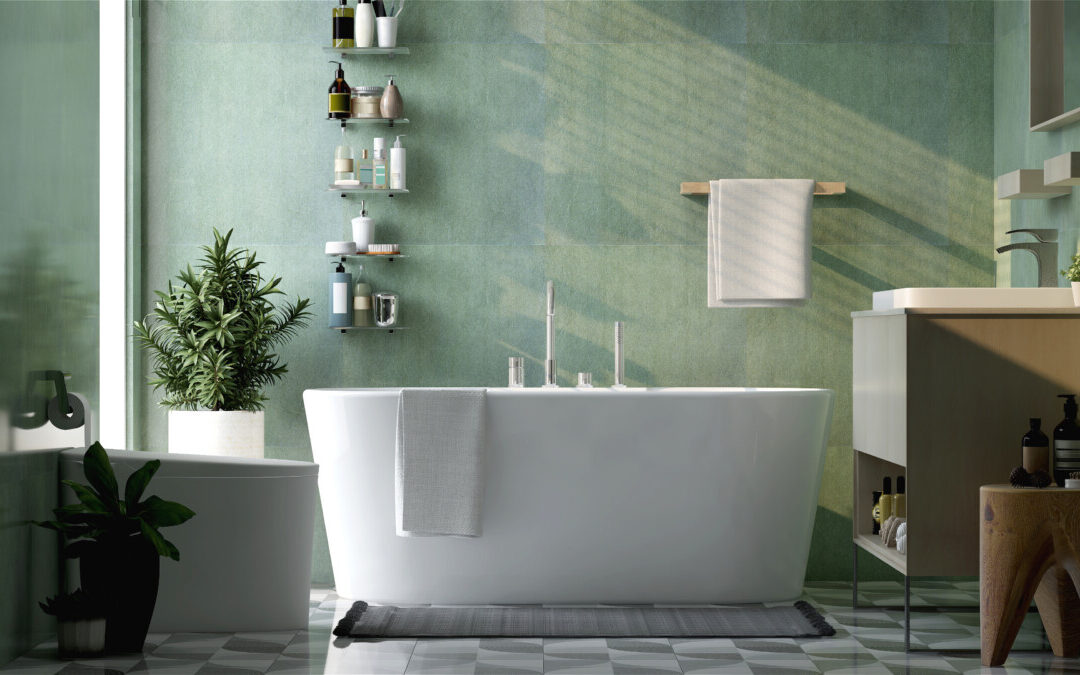
by Joel Griffiths | 7th Aug, 2024 | Inspiration
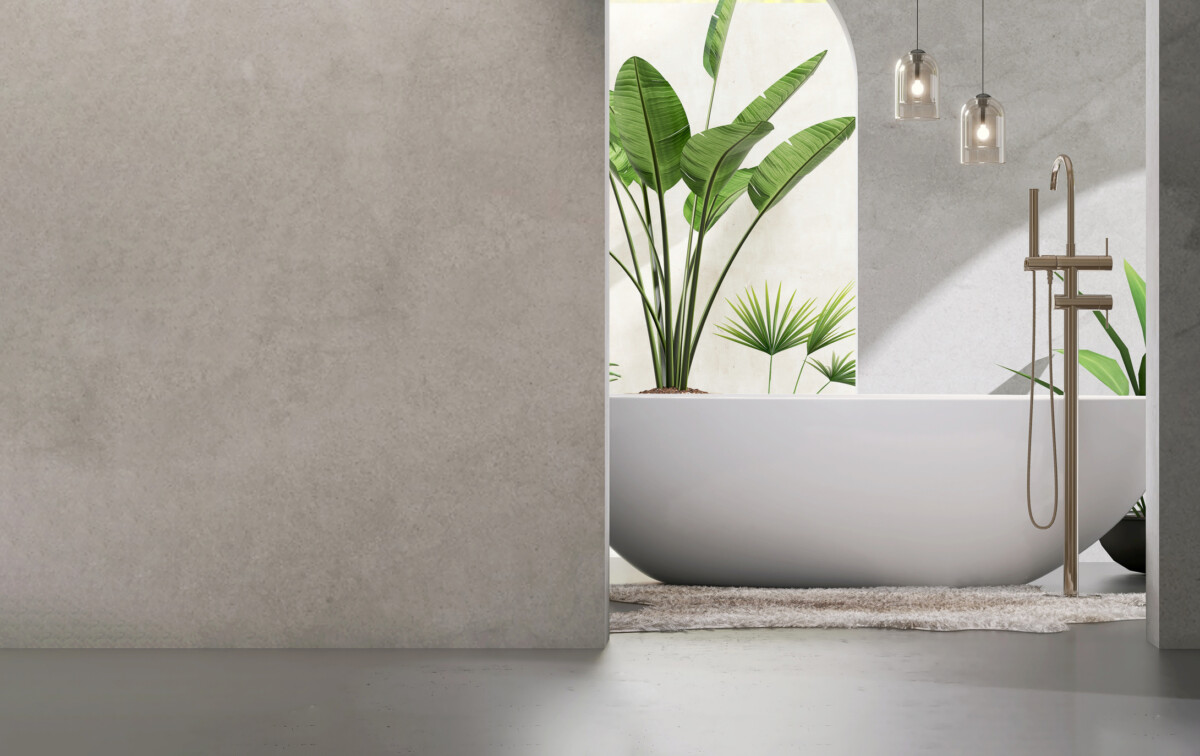
If neutral-toned tiles, blank walls, and basic fixtures aren’t really your thing, then you’re in the right place. In this post, we are going to show you how wallpaper can effortlessly bring vibrancy to your room.
We have wallpaper bathroom ideas that can add personality, style, and uniqueness to your space thanks to their colours, prints and patterns. Discover bold and bright graphic-adorned designs, as well as tonal options with subtle textures. Below we’ve created a list of different wallpaper styles, including the pros and cons of each – and which bathrooms they would suit best. Let’s dive straight in…
Grey
Grey wallpaper is a timeless option. It’s a versatile and sophisticated hue that promises to blend into any atmosphere without drastically changing the vibe of a bathroom. It has a calming undertone and will effortlessly add interest to the wall, without being loud or brash. Discover subtle textures, discreet patterns, and barely-there off-white shades to more daring charcoal colours.
Grey wallpaper is an excellent choice if you want something elegant and smart. It can add depth, dimension, and shadows to the bathroom. Plus, it’s ideal if you’re not sure what colour to go for, or if you don’t want something too bold. There’s a whole spectrum of grey shades to pick from depending on the level of grey you love. Plus, it’ll match with your existing fixtures and décor with no fuss.
Grey wallpaper can often have duller undertones, therefore in smaller spaces, it can make the room feel more enclosed. Some would also say that these shades have a ‘cold’ effect and make bathrooms feel more sterile if not balanced with warmer décor.
We’d suggest a grey wallpaper for larger, airy rooms. Possibly a space that has lots of natural light. If you love grey tones but have a smaller room, we’d suggest picking a light variation of the colour, rather than going too dark, as this could make the space feel even smaller.
Tropical

Be inspired by far-flung destinations and the wildlife of the jungle with vibrant designs featuring tropical greenery, exotic flowers, and a whole host of rarely spotted animals. After all, your bathroom was designed for balmy temperatures and humid conditions.
Tropical wallpaper will instantly enliven your space. These wallpapers are usually finished in bright colours that will bring energy and life into your home. They also become a talking point – a far cry from plain-coloured tiles and walls. It’ll help bring a lively atmosphere to your space like you’re exploring the outdoors every time you bathe.
However, sometimes, in smaller rooms, tropical wallpaper can be a bit much. It can look a little fussy if it’s not mixed with other decor. Another thing to consider is the colour and décor of your current fixtures. Because this paper is bold and made to be seen, it can often clash with other colours.
We’d say this type of paper is best for feature walls in smaller rooms with mobility style baths, or creating a stand-out tropical themed bathroom in larger spaces.
Request a Free Brochure
Simply fill out a quick form and see how we can transform the way you bathe.
Request Free Brochure
Black and white
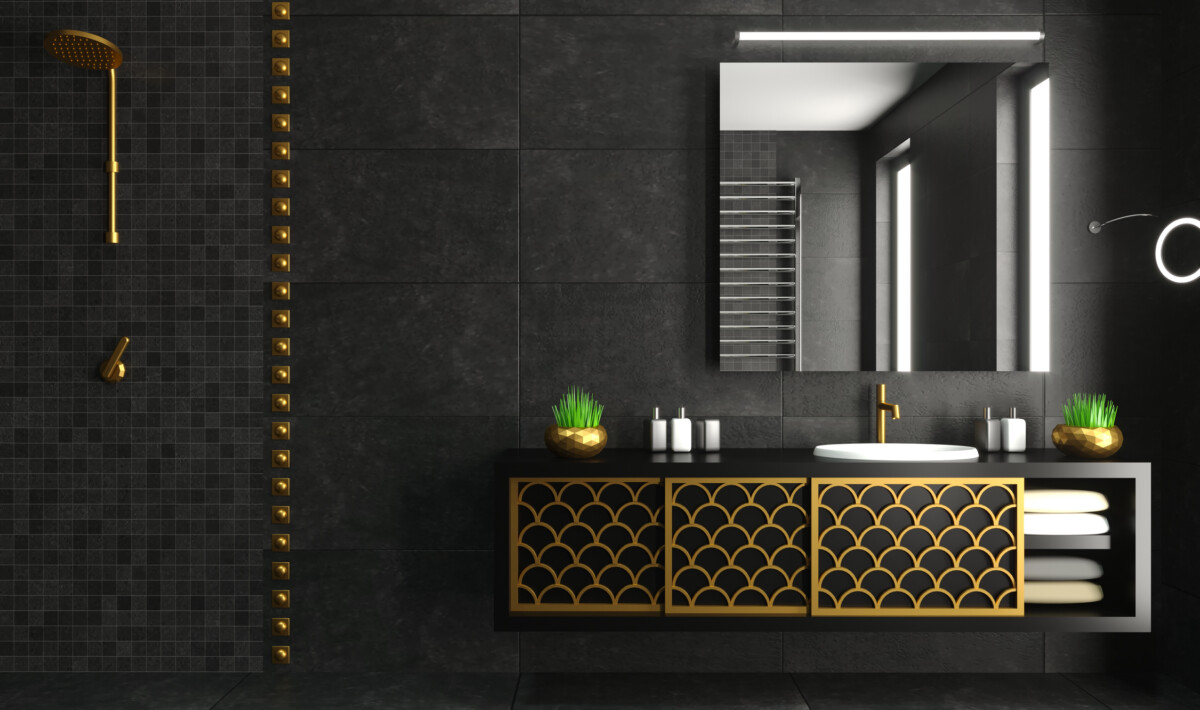
Master the monochrome look with black and white coloured wallpaper. This style offers a bold statement look for any bathroom, and one that is timeless. This could include bold stripes, chequerboard, abstract art or plain and textured.
Black and white wallpaper is very modern and striking. The hues are completely timeless, meaning you won’t have to re-wallpaper for a while after you’ve applied due to it going out of style. It’s often quite versatile, too and will go with your current fixtures and fittings, even in a disabled bathroom.
However, if you go for something too overpowering, block black colours can be quite in-your-face. I you’d prefer a more subtle touch, you may want a lighter hue that doesn’t offer as much contrast. Also, if you choose a print or pattern, it may need careful alignment and, as such making it more of a fiddly job to apply.
Green
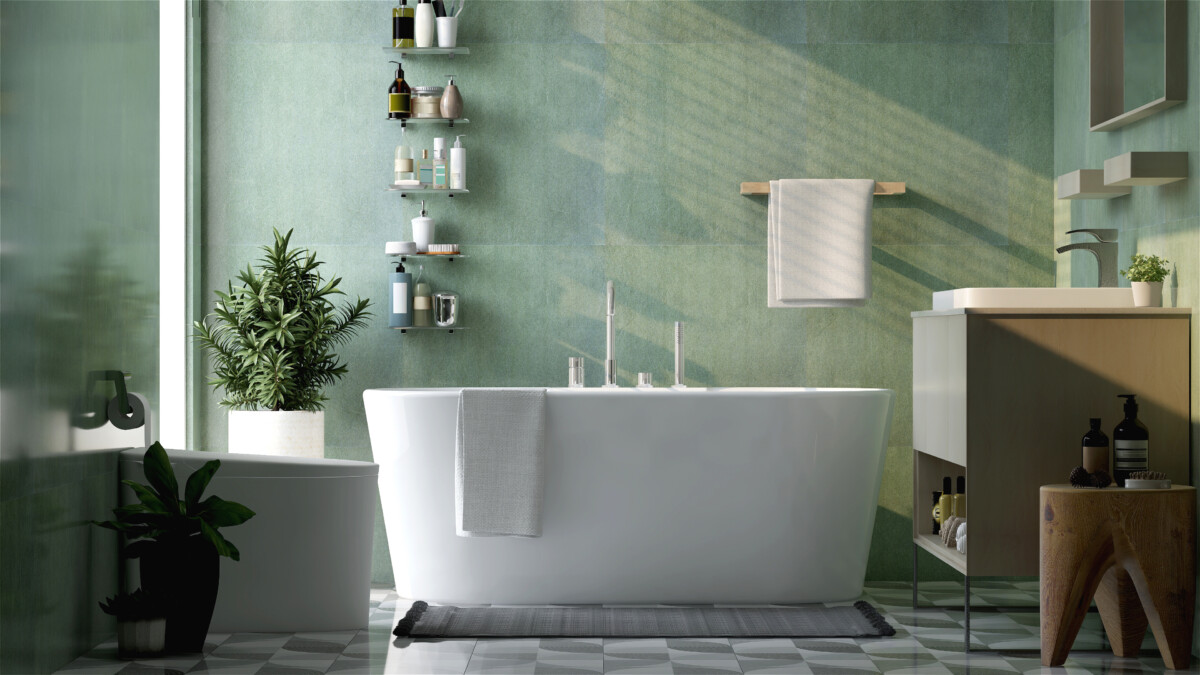
Go for the refreshing and vivid colour of green wallpaper. It can bring a sense of the outdoors, inside. You’ll benefit from the relaxing well-being benefits that nature and tranquillity offer. From on-trend sage to deep forest hues – there are plenty of shades to choose from. If you love pastels, light mint and lime will effortlessly perk up your walls.
Green wallpaper provides a serene environment. Your bathroom should be a place where you can relax and unwind, so of course the soft and soothing effect of this colour works wonderfully. It’ll also add depth and dimension to your space. Green pairs perfectly with classic fixture colours of white, brass and silver – so you can be sure it won’t clash.
Occasionally, if you overdo it on accessories, green wallpaper can be a little busy. If you’re using a vibrant shade of green it could appear quite bold when used on all four walls – therefore you may consider a pastel hue or just doing a single feature wall. As with all colours they can come in and out of date quite quickly, so make sure it’s a colour you love and not one that’s just following the newest trends.
Funky
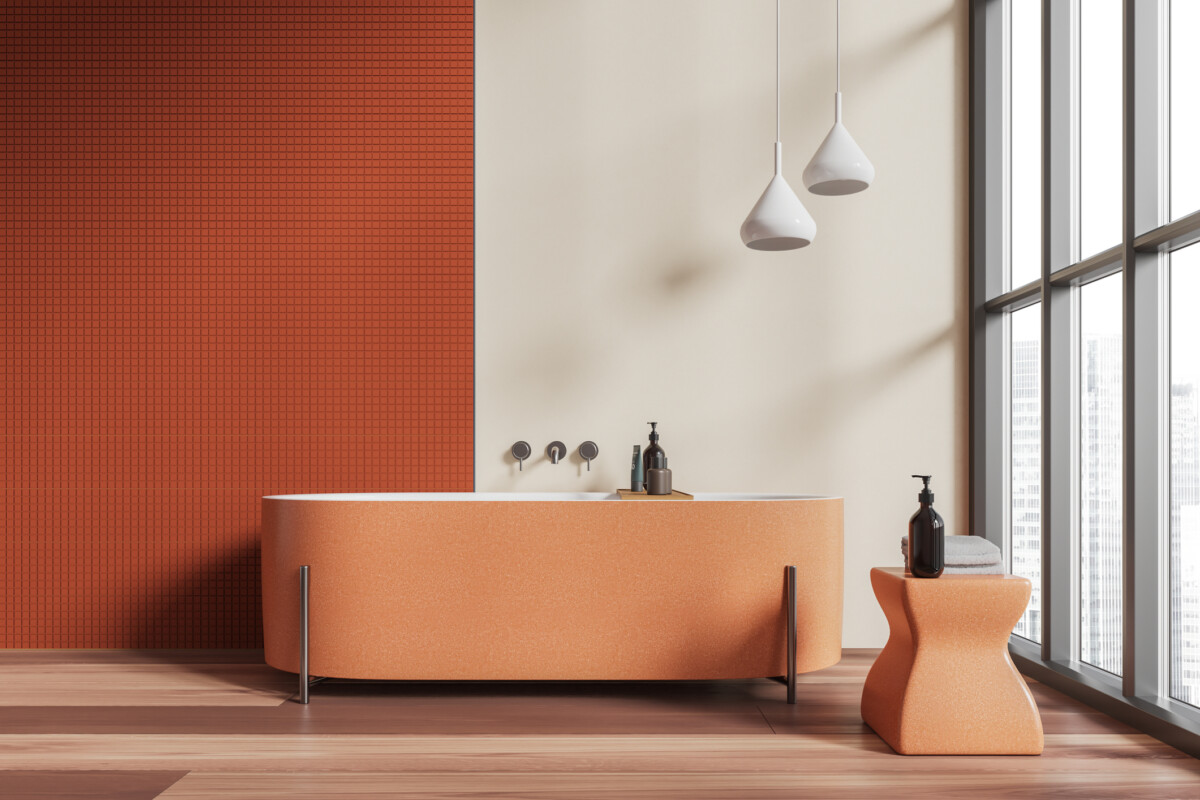
To completely transform your space, why not go for a funky wallpaper? We’re talking about one-of-a-kind prints, vibrant colours and playful styles that will make heads turn every time visitors powder their nose.
There’s no doubt funky wallpaper is that it will truly set your bathroom apart from the rest. Whether you choose bold geometric prints, animal patterns or artistic murals – you can be sure they’ll become an instant talking point. Your bathroom should be your sanctuary, so why not fill it with designs you adore? If you’re going for playful prints, then you’ll add a light-hearted atmosphere to your space, while bright psychedelics will add a touch of personality and creativity to your home.
However, something to keep in mind is that due to a larger-than-life personality, funky wallpaper can be easier to get fed up with. If you compare that to choosing a plain tonal hue – it is not something that draws your eyes every time you enter the room, so it wouldn’t be something you get bored of. It is also something that requires an eye for design – and ensuring you can balance it with the surroundings of the bathroom.
How to choose a bathroom wallpaper
Finding your perfect bathroom wallpaper can really transform the space and make your home feel more ‘you’. But of course, there are several factors you may want to consider before investing. Here are a few points to help you make an informed choice:
Consider your bathroom space and layout
Is your room compact or roomy? Does it have a simple 4-wall layout or a more unconventional one? How much wall space do you have?
The larger your room, the bolder you may want to go. Or if it comes down to budgeting, you may just want to wallpaper a single feature wall. For small bathroom wallpaper ideas, you may prefer to go for light, airy colours that’ll help the room feel a lot bigger.
Make sure it suits your bathroom style
If your bathroom is full of traditional features and vintage carpentry – then you’ll probably want to go for a more rustic aesthetic of paper. Whereas if your room is full of the latest fixtures, like a sleek white walk-in shower and a fresh marble floor, then you’ll want to choose a modern design.
As a part of this you’ll want to balance the paper you choose with the fixtures you already have – making sure that they don’t clash.
Ensure it’s appropriate for the bathroom
Your bathroom will get warm and humid, therefore it’s essential the style you choose is designed with waterproof finishes, or specially crafted bathroom paper. This way, you’ll find it easier to clean too.
Wallpaper can instantly refresh the whole feel of your bathroom, and without too much work. There are so many different styles, patterns, prints and colours to go for, so it’s important to consider the design of your current bathroom, its fixtures, and your personal preference.
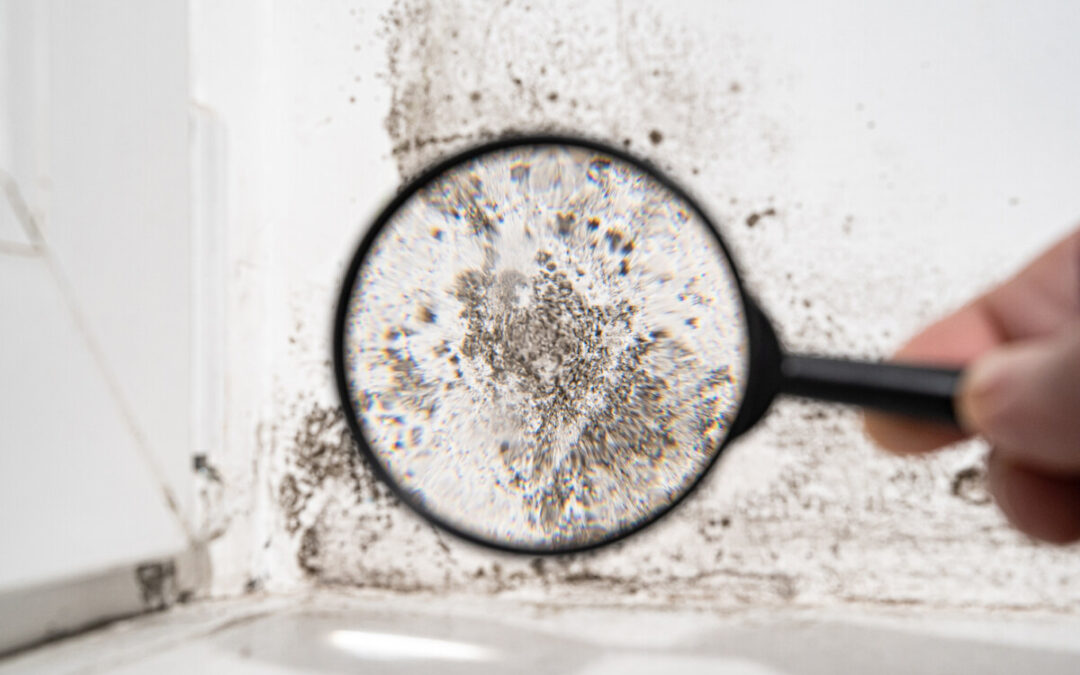
by Joel Griffiths | 7th Aug, 2024 | Health
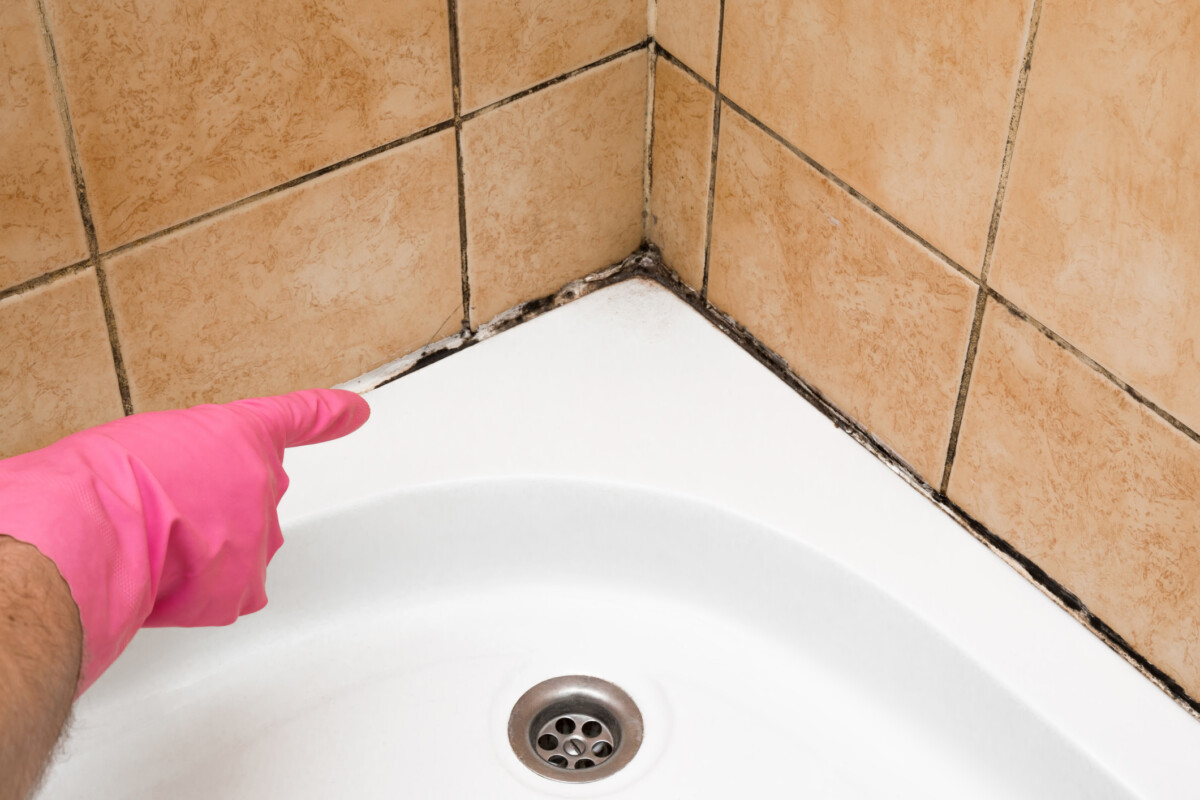
Mould is a common (and pesky) problem in many households across the UK. It can especially become a problem in bathrooms because of the persistent damp conditions and high humidity in this area.
Mould can be an unsightly issue to have in your home, but not only that, it can become a health risk if not dealt with correctly. So, are you wondering how to get rid of mould in your bathroom? You’re in the right place, as we’ve detailed how you can get every surface gleaming, and back to the safe and healthy environment you deserve. Read on to understand everything from how to remove existing mould to how build-up can be prevented going forward.
Tools and materials you’ll need
Before you begin to carry out any work to effectively remove mouldy sealant in your bathroom or walk-in shower, you’ll need a few pieces of essential tools and equipment. These are:
- A utility knife or a sealant remover tool that will cut and scrape away old sealant that has mould
- A cleaning solution to treat the area before reapplying sealant. This could be a commercial-grade mould spray, or you can make your own solution using bleach and water
- A sponge, cloth or scrubbing brush to apply and remove the cleaning solution
- Protective personal equipment such as rubber gloves and a face mask that’ll prevent you and your skin from coming into contact with any harsh chemicals or mould spores
- A new, mould-resistant bathroom sealant
- A caulking gun to neatly apply
If you have everything listed above to hand, then this will ensure a smooth process when you go to tackle any mould in your bathroom.
How to get rid of mould in your bathroom
We’ve detailed how to say farewell to any bathroom mould in just a few easy steps – showing that it’s simple to do yourself and keep on top of any issues.
Step 1: Clean the affected area
Making sure that you have your protective gear on – it’s time to get to work with an easy bathroom clean, to remove mould that may be in the area.
To do this, use a ready-to-go solution of commercial mould remover, or fill a spray bottle with a bleach solution. Your mix should be one part bleach to three parts water.
Once you’re equipped with your cleaner, spray it generously to the affected areas and let it sit for around 10 minutes.
After letting it soak into the mould for 10 minutes you can get to scrubbing. Take a brush, sponge or cloth and rub the affected surfaces thoroughly. Areas that can be commonly affected are grout between tiles, hard-to-reach areas like behind taps and hidden crevices where you keep toiletries and bottles.
Once you’ve cleaned the surface, you can now rinse off any residue. Do this easily with your bathroom shower head, or alternatively fill the bath or a bucket with fresh water and use this to wipe over the surface.
After rinsing, you’ll want to dry the surface off using an old towel or cloth.
If you want more tips on how to clean your bathroom without straining your back, click through here.
Step 2: Remove and replace bathroom sealant
Once you’re working with a clean canvas, you can now begin to remove your old, mould-covered sealant.
Most DIY stores will sell kits to help you remove old sealant, but it can also be cut away quite easily with a utility knife.
To do this, simply slice down the edge where the sealant meets the wall and pry it away.
If there are any areas that are particularly stubborn, you might find it easier to use tweezers or a small pair of pliers to pull it off.
You should now have a sealant clear area, but if there are still residual pieces, you can scrape these off carefully using your utility knife.
It’s now time to clean your surface again, particularly the part of the wall that was previously covered by sealant. By doing this it ensures any mould or mildew particles that are still lingering on the surface are killed before a new sealant is applied.
To apply a new sealant, you’ll want to put a mould-resistant bathroom sealant into your caulking gun. Using the tool, gently squeeze the formula evenly across all edges, joints and seams in your bathroom. You should make sure you’re applying this anywhere that water may leak or run – to prevent bigger mould issues happening in the future.
Once you’ve applied the sealant, you can run your finger along it to smooth it out. There are also caulking tools available at most DIY stores to give you that same seamless finish.
The sealant will take a while to cure and set to solid. Read the tube that you used for full drying times, however we’d recommend leaving it for 24 hours before using your bathroom.
Step 3: Mould-proof your bathroom for the future
Voila, all traces of mould have been cleaned and removed from your standard or disabled bathroom and it’s back to a sparkling condition. But, how do you prevent it from coming back in the future?
This step gives you practical advice on how you can avoid any mould reappearing:
Mould thrives in humid, warm environments, so the best way to improve the atmosphere of your bathroom is to make sure it’s well-ventilated. That could be by using an extractor fan, keeping windows open after showering, or even using a dehumidifier.
As well as lowering the humidity in your bathroom, it’s important to keep on top of cleaning. There are plenty of mould prevention cleaners that can be incorporated into your usual cleaning routine. Make sure you focus on those hidden spots under taps and in corners, as well as on grout, as these are the most common places for mould to grow.
Request a Free Brochure
Simply fill out a quick form and see how we can transform the way you bathe.
Request Free Brochure
FAQs
What is black mould in a bathroom and why does it appear?
Black mould is a type of fungus that appears as dark green or black coloured blobs. It thrives in humid and damp conditions – hence why it appears so often in bathrooms.
Is mould in the bathroom dangerous for your health?
Mould, particularly black mould is associated with a variety of health problems, hence why we encourage anyone to follow the steps on this guide to remove it as soon as possible. That’s because inhaling spores from mould can cause respiratory issues like coughing and throat irritation. As well as that, it can have toxic effects if you’re exposed to it for a prolonged period.
How can I identify mould in my bathroom?
There are several types of mould that may appear in your bathroom. The most commonly recognised due to its dark shade is black mould. This appears in dark patches and will contrast against your surfaces, making it easy to spot. White mould is a fuzzy type of mould that you might see on walls. Another way that you might first notice mould is through its scent – which is often a damp, musty smell.
Can I prevent mould from forming in my bathroom?
Yes! We’ve detailed some easy ways to prevent mould from forming. These are having good ventilation in your bathroom by opening windows and using extractor fans. It also includes cleaning regularly with preventative mould sprays.
Maintaining a mould-free bathroom is essential, not only for keeping a clean home, but ensuring its longevity. It is also vital for ensuring your own personal good health. We recommend being vigilant when spotting mould in your bathroom, and if you do come across areas of concern, to treat them as outlined in this guide.
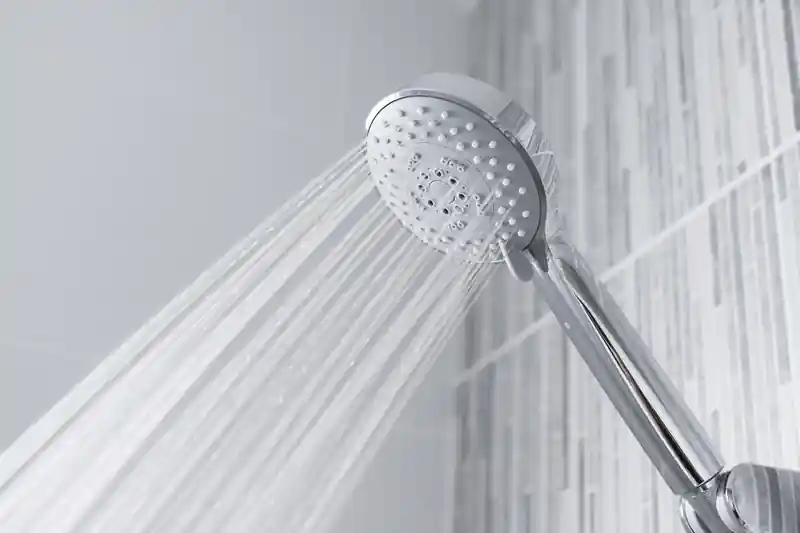
by Jon Pearce | 15th Apr, 2024 | Walk-in showers

Nothing is worse than standing under a dribbling shower with terrible water flow. You turn the pressure to maximum, but nothing happens. So you shower quickly, trying to rinse out shampoo and wishing for better water pressure. In this article, we’ll explain how to tell if you have low shower pressure and ways to increase it for the best showering experience.
Is your bathroom challenging to use?
Simply fill out a quick form and see how we can transform the way you bathe.
Request Free Brochure
- What is water pressure?
- Signs that you have low shower pressure
- How to check your water pressure
- The benefits of increasing shower pressure
- How to increase shower pressure
What is water pressure?
Water pressure is the strength that forces water through pipes and into household water fixtures, such as taps, dishwashers, washing machines, and showers.
You can have a high amount of water flow but low pressure. For example, a shower head that releases lots of water but is too gentle and doesn’t have the strength to wash over your body. However, most commonly, people with low water pressure also experience low water flow, such as a tap that only releases a small amount of water very slowly.
Signs that you have low shower pressure
If you’re unsure whether your water pressure is low, here are a few signs to look out for:
- All your water fixtures are weak – It’s not just your shower that has low pressure, but every water fixture in the house. For example, the bathroom taps or a slow-filling toilet. Or maybe your dishwasher and washing machine take a long time to reach their water capacity.
- You can’t run more than one water fixture at once – Perhaps your shower works okay, but the water pressure instantly drops as soon as someone runs the kitchen tap. You’re left waiting for them to fill the kettle before you can enjoy decent water pressure again.
- Your shower fails the water pressure test – You can do a simple water pressure test to see if the pressure is normal or too low. Follow the instructions below:
How to check your water pressure
You don’t necessarily need a plumber to see if you have poor water pressure. Instead, there’s a quick test you can do at home.
Step 1. Get a 1-litre measuring jug and place it under the shower head. Then, turn on your shower to maximum water pressure.
Step 2. Record how long it takes for the measuring jug to fill with water.
Step 3. Once the jug is full, stop the clock. If it took over 6 seconds to fill, your shower head failed the test, and you have a low pressure shower.
The benefits of increasing shower pressure
You might not see the need to fix low shower pressure. However, having a shower with great water pressure has multiple advantages.
Rinses out shampoo better
When the shower stream is too weak, shampoo can remain in your hair, along with dirt and sebum production from the scalp. And even if you manage to rinse it out, it can take a long time. High shower pressure lets you wash out shampoo with far less effort, which is excellent news if you struggle with joint pain and fatigue while showering.
Eases tense muscles
A shower with good water pressure effectively targets muscles. The hot water can reach tense points, calming inflammation and relieving aches and pains.
Keeps you warm when showering
Poor shower pressure is never fun, but it worsens in winter. You may start to dread showering. And that’s because it’s spent shivering in a cold bathroom with a trickle of water dribbling from your shower head. Good water pressure will cover your body, making showering more enjoyable, especially during the winter months.
Quicker showers
Instead of waiting for low water pressure to cleanse your body, high shower pressure will lather up shower products and rinse off suds more quickly. That means quicker showers and less water wastage.
How to increase shower pressure
Once you’ve discovered if you have low shower pressure, it’s time to fix it. Keep reading for the best ways to increase your shower pressure.
Clean out your shower head
Before you investigate your plumbing, the first thing to check is whether you have a blocked shower head. Over time, minerals and limescale accumulate and can clog the shower holes, preventing the water from flowing through efficiently.
How to clean out your shower head for better water pressure
Start by unscrewing the shower head and checking if anything is trapped in the neck of the head. You can do so by simply looking or gently inserting and twisting a pipe cleaner brush. Ensure you don’t shove the brush into the neck, as it may lodge something close to the shower head.
Once you’ve checked the neck, it’s time to clean the shower head’s holes. Using a rubber band, attach a bag filled with white vinegar to the shower head. This is best done when the shower head is still attached to the wall. Leave overnight to unblock and dissolve limescale and minerals. Rinse the shower head under water and use something small, such as a cocktail stick, to make sure all the shower holes are unblocked.
Change your showerhead
If you’ve unclogged your shower head and are still experiencing low water pressure, it may be time to replace it. Our digital shower heads contain Flipstream technology, allowing you to switch between 4 types of shower spray settings. The variety of jet streams maximise your water pressure and turn an average shower into a luxury experience.
Smooth out your shower tube
Handheld shower heads have a flexible pipe that attaches the head to the main shower. Sometimes, this can get bent and twisted, preventing water from flowing smoothly. Take the time to unwind the shower tube, checking for any kinks and twists.
Install a shower pressure booster
A shower pressure booster or pump gives your water supply a helping hand and increases the rate at which water passes through your pipes. It’s particularly helpful if you live in a home with an old water system. Or if you live in a high building, which makes it difficult for water to reach your shower.
Switch to a digital shower
Cheap electric showers often struggle with low water pressure, so switching to a well-functioning shower will help.
Our digital electric showers combine hot and cold water for your ideal water temperature and use a thermostat for precise temperature control. All you need to do is turn on the shower and set your temperature. The innovative technology sends a wireless signal to the built-in thermostat (no Wi-Fi required) and regulates the heat while you’re showering. So, there’s no need to constantly adjust a dial for the perfect temperature – just touch a button, and go!
Mobility Plus digital showers are compatible with all our wet rooms and walk-in showers.
Check if your piping is blocked
A reason for low shower pressure could be that something is blocking your pipes. It may be a clog in your house piping (for example, from a buildup of hair, oil, and food) or in your area’s piping system. If you suspect a blockage is causing low water pressure, call a plumber or contact your local council for an area check-up.
Enjoy every shower with Mobility Plus
You don’t have to put up with weak shower pressure. Choose from our unique walk-in showers and wetrooms and combine them with a digital shower for a luxurious showering experience. Don’t compromise on cleanliness, and shower in peace and comfort with Mobility Plus.
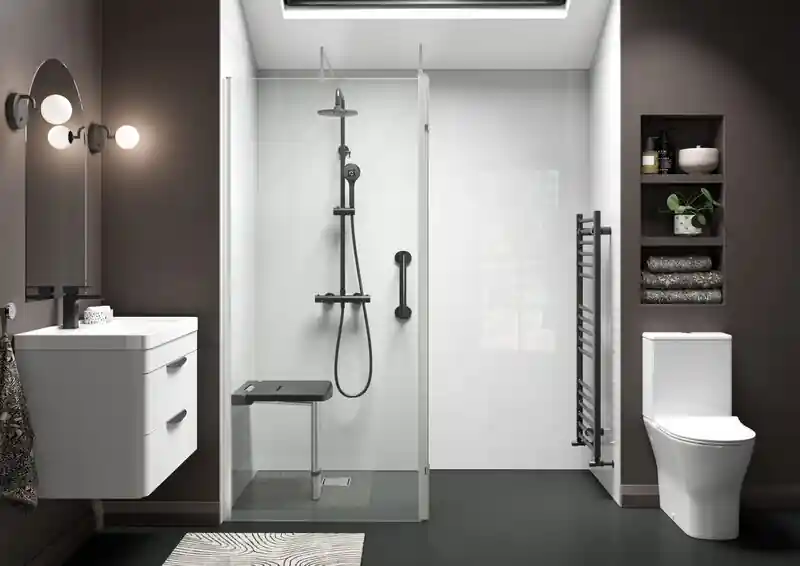
by mobilityplus | 20th Feb, 2024 | Blog, Walk-in showers

It’s time for a shower upgrade, but what should you choose? It seems there are endless options – power showers, electric, digital, and that’s not to mention the type of shower enclosure. Do you choose a quadrant enclosure, stable door shower or wet room? And, most importantly, do they suit your mobility needs?
Digital showers
In this article, we take you through the different types of showers and shower enclosures, including key features and benefits. You’ll walk away informed and knowledgeable about the best shower to buy for yourself and your loved ones.
Request a Free Brochure
Simply fill out a quick form and see how we can transform the way you bathe.
Request Free Brochure
Different types of shower enclosures
A shower enclosure (also known as a shower cubicle) is the space you stand inside while you shower.
When looking into shower enclosures, a solid starting point is the space in your bathroom and accessibility needs. And let’s not forget the style. You want to like your shower and enjoy using it. Read on for the top shower enclosures.
Quadrant shower enclosure
A quadrant shower has two straight edges and a curved screen that slots neatly into corners. They are ideal for small areas or a bathroom with an odd layout.
A quadrant shower is a walk-in shower, which means you don’t have to step into a bathtub or encounter the barrier of a high shower tray. It’s an excellent option if you have limited mobility and need some elbow room to move around.
The Richmond Quadrant Enclosure is designed to fit seamlessly into corners and awkward areas of the bathroom.
Its sliding screen door has a low-entry, slip-resistant shower tray. Magnetic seals ensure there’s no leaky sealant or shower spray on your bathroom floor. With a minimal and sleek aluminium frame and a chrome finish, you can appreciate the pleasure of accessibility and style all in one.
Benefits of a quadrant shower enclosure
- Space-saving corner design
- Excellent access
- Stylish and simple
- Comes with integrated grab rails and a shower seat
- Ideal for small areas or awkward-shaped bathrooms
Offset quadrant shower
An offset quadrant shower is similar to a standard quadrant shower, except it has one extended side and fits best into wider corners. The longer side creates additional space, which is excellent if you need more room to move. It’s another type of walk-in shower, making showering safe and easy.
Our Richmond Offset Quadrant Shower Enclosure comes in custom sizes to fit perfectly into your bathroom. The seamlessly sliding, curved doors open and close on rollers, so there is no need to tug or struggle to get in and out. The low, slip-proof shower tray eliminates the worry of tripping and is easy on the joints.
The Mobility Plus Offset Quadrant Shower Enclosure also has a comfortable folding seat and grab rails to increase independent showering.
Benefits of an offset shower
Space-saving corner design
- Slip-resistant shower tray and trip-free access
- Sleek and stylish
- Accessibility-friendly
- Extra space for manoeuvring
Wet rooms
Wet rooms don’t have a self-contained shower. Instead, the shower is flush to the floor rather than inside a cubicle with a shower tray. The entire room is waterproof, with a sloping floor for effective draining. They are helpful for people with limited mobility or wheelchair users.
Our stylish wet rooms are suitable for almost any bathroom space and don’t have the barrier of a shower tray. They are ideal for a sleek, contemporary look and appropriate for everyone, whether you have mobility issues or not.
Benefits of a wet room
- Perfect for wheelchair users
- Suitable for most bathrooms
- Adaptable for all mobility types
- Stylish and modern
Stable door shower enclosure
A stable door shower has a split screen, so the top half can open. The feature makes it convenient for a carer to provide support when showering, which is perfect for assisted living. The screen can also be returned to its full height to accommodate others who shower independently.
Stable door showers are best for larger bathrooms as they have a straight-edged, cube design. This generally requires more space than curved doors on quadrant showers.
Our walk-in Coniston Stable Door Shower Enclosure has a stylish brushed satin finish and comes in full and half-height panels. You can choose from clear or frosted glazing and add shower curtains for privacy, and it has the benefit of a low-level shower tray.
Benefits of a stable door shower enclosure
- Customisable for your accessibility needs
- Perfect for assisted showering
- Long-lasting with a thick frame
- Modern and stylish
Types of showers
Once you’ve chosen your shower enclosure, it’s essential to pick a shower that suits you. When choosing, consider your boiler, water pressure and the installation process. But ultimately, the best shower to buy is one that suits you and your accessibility needs.
Digital shower
Digital showers use innovative technology to control the start, stop and temperature of the shower. It combines hot and cold water in the shower valve for the ultimate showering experience.
Digital showers allow you to control your shower with just the touch of a button. The cutting-edge technology uses an optional wireless remote to start and stop the shower, change the water temperature and adjust the shower spray. Digital showers work well with any type of shower enclosure as they enhance accessibility needs.
Best for:
- Combi boilers
- Anyone who struggles with bending down or reaching up
- Technology lovers
- Carers to assist with showering
- Setting the water to a precise temperature
- All types of shower enclosures
Power showers
Power showers mix hot and cold water for the optimal temperature. They use a shower pump to increase water pressure, ensuring a pleasant showering experience. They are great if you have low water pressure and complement the modern design of a quadrant shower enclosure. Wet rooms also work wonderfully with power showers for a lavish experience.
Best for:
- Combi boiler
- Low water pressure
- Levelling up your showering experience
- Quadrant enclosures and wet rooms
Electric shower
Electric showers use electricity to heat water with a hot water cylinder. Instead of relying on a hot water tank, it uses cold water, which is good news if you frequently find your hot water running out. Electric showers work well with stable door shower enclosures as the pressure isn’t too high.
Best for: Gentle water pressure
- Hot water tanks that quickly run out
- Modern houses or new builds
- Lowering water wastage
- Stable door shower enclosures
Electric vs power shower
Whether you choose an electric shower or power shower depends on your personal preference. Electric showers use less water and have an independent heating element to warm your water supply, but they can be low-pressure.
Power showers increase water pressure for better water flow, creating a spa-like showering experience. However, they use more water and may feel too harsh on sensitive skin.
Mixer shower
Mixer showers combine hot and cold water and can be used with most boilers. However, they won’t increase pressure, so they may be unsuitable if you have low water pressure. An electric shower or shower mixer is generally good for homes with decent water pressure and a budget-friendly option. Mixer showers are great for quadrant and stable-door shower enclosures.
Best for:
Already good water pressure
- Combi boilers
- Quadrant and stable door shower enclosures
Choose the perfect type of shower with Mobility Plus
Our extensive range of showers is sure to accommodate your accessibility needs. Choose a contemporary chrome finish, elegantly curved door or accessible half-height screen. With low-level, slip-resistant shower trays, integrated grab rails and shower seats for safety and comfort, you’re sure to find the perfect shower with Mobility Plus.
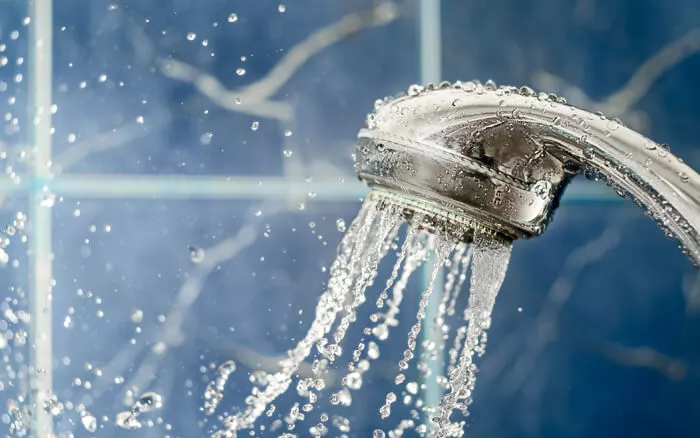
by mobilityplus | 3rd Dec, 2023 | Health

Taking a shower can provide us with some much-needed reflection time, whether this be before the start of the day or at the end of it. Most of the time though, people in the UK are taking warm showers, as they are generally quite nice and pleasant and allow us to ease into the day. However, a growing number of people in the country are switching to have cold showers, because they have a wide range of health benefits.
In this article, we discuss the health benefits of a cold-water shower that you can take advantage of. Cold showers may not be everyone’s cup of tea at first, but once you find out about some of these, you may begin to realise why they are becoming more popular.
What is cold water therapy?
You might’ve also come across this phrase before. Cold water therapy, also referred to as cold hydrotherapy or cold water immersion, is a rejuvenating practice where your body is exposed to cold water, typically below 15°C, to promote health and well-being.
There are many ways one can undertake cold water therapy like an ice bath or outdoor swimming, but today we’re going to be focusing specifically on cold water showers and its benefits.
Looking for better temperature bathing control?
Simply fill out a quick form and see how we can transform the way you bathe.
Request Free Brochure
- Increases alertness
- Healthier hair
- Improves blood circulation
- Stimulates weight loss
- Speeds up muscle soreness and recovery
- Eases stress
- Relieves depression
- Improves emotional resilience
- Boost fertility
- Anti-ageing
1. Increases alertness
For those who find it a little tricky to wake up in the morning, a cold-water shower is the remedy that you need. One benefit of a cold shower is it has lasting effects to amp up your alertness for the day. History tells the tales of Spartans using cold water showers to enhance mental and physical strength to make them more alert in combat.
Dr. David Greuner, Cardiovascular surgeon of NYC Surgical Associates said “Cold showers are a great antidote for waking you up in the morning after a late night. Anything that surprises or shocks you will bring on the fight or flight response and raise your level of alertness”. This sounds a little distressing for first thing in the morning, but if you’re feeling a tad groggy then this could be just the thing you need to wake up and seize the day!
2. Healthier hair
To give your hair a boost, a cold shower will help lock in moisture after you shampoo and condition your hair. It helps to tighten cuticles in your scalp to make sure your hair is well rooted, which can lower the chances of hair loss. It’s a win-win.
3. Improves blood circulation
As we age, our blood circulation tends to decline, and there is greater importance to counteract the overall effect on the body. A perhaps lesser-known benefit of a cold shower is that healthy blood circulation provides oxygen to the brain and other vital organs. Interestingly, alternating between hot and cold water while you shower can help improve overall blood circulation.
4. Stimulates weight loss
Could this cold shower benefit be the weight loss hack you’ve been waiting for? Scandinavian researchers found that cold temperatures increase the metabolic rate of fat, and if this practice is sustained it can help strip away 9 pounds of fat a year. The researchers would still recommend a healthy diet and consistent exercise to support this weight loss.
5. Speeds up muscle soreness and recovery
Cold water therapy is widely known to speed up the process of muscle repair. Athletes often take cold showers or ice baths to relax their muscles after a hardcore workout or intense match. In this study, the researchers analysed 360 people across 17 trials who plugged themselves in cold water after rigorous exercise. They found that cold water baths were very effective in reducing muscle soreness.
6. Eases stress
Stress is one of the most common health concerns around the globe, and many of us are seeking the most effective ways to manage this. The “shock” effect to the skin from getting a cold shower can make people more tolerant of stress, particularly if this is repeated over time. This study shows that cold showers are a form of oxidative stress on the nervous system, and over time the participants felt more “calm”.
7. Relieves depression
Research shows that consistent blasts of ice-cold showers are great for improving levels of wellbeing. Dr Nikolai Shevchuk believes that we need to be exposed to more thermal stress on the body, as it releases hormones that are often found in anti-depressant medications.
8. Improves emotional resilience
As previously mentioned, taking consistent showers can help you tolerate stress, which, in turn, improves your emotional resilience. Regular and consistent cold showers can ensure that your body will get used to the sensations.
9. Boost fertility
Although there isn’t a wide range of research, some small studies have found that there is evidence that suggests that cold showers can increase male fertility to some degree. Hot baths have been shown to reduce the level of sperm count, and cold showers are a good counter activity to reverse the effects.
10. Anti-ageing
With better blood circulation, your skin will also appear healthier and clearer as it will help nourish the skin tissue cells. The more oxygen circulated around the body, the more radiant and polished the skin will feel and look. Many studies have also been conducted to show that stress can age the body, and cold showers are a good combat for this too.
Conclusion
Cold showers are a great example to add to your self-care routine. We’re automatically accustomed to hot showers, particularly in the winter season; but perhaps this could be a new routine of relaxing after a long day or before the day has begun.
Taking the plunge into having regular cold showers can be daunting, but as we’ve seen there are significant health benefits. You do not need to switch completely to cold showers, but potentially alternating between cold and hot can be a good way to ease into the process and reward yourself if you’re finding it slightly harder to become accustomed to!
Cold showers are a great example to add to your self-care routine. We’re automatically accustomed to hot showers, particularly in the winter season; but perhaps this could be a new way of relaxing after a long day. At Mobility Plus, our wellbeing and health are a priority, take a look at our other health-related articles on our blog here. If you are interested in easy-access bathing solutions, see our walk-in bath and shower ranges.
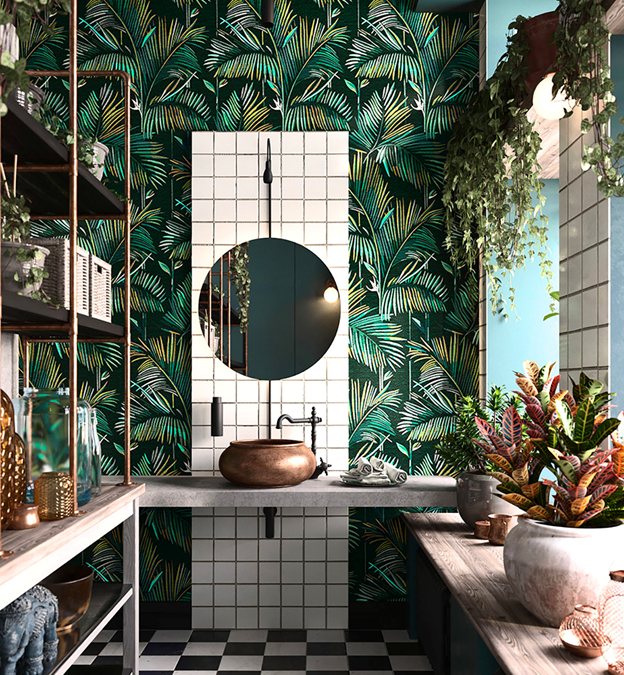
by Jon Pearce | 23rd Nov, 2023 | Inspiration
Small bathrooms don’t need to sacrifice comfort or luxury. They can include everything you need for a stylish and functional bathing area, from beautiful vanities to stunning walk-in showers. You just need to know how.
This guide will show you 25 walk-in shower layout ideas for small bathrooms, using real-life examples to help you picture your perfect bathroom. Once you’re finished reading, you’ll know exactly how you can transform your limited space into a stunning bathroom that suits your needs and impresses your guests.
Is your bathroom challenging to use?
Simply fill out a quick form and see how we can transform the way you bathe.
Request Free Brochure
1. Corner walk-in shower layouts for small bathrooms
A corner walk-in shower is a great option for small bathrooms because it takes up minimal floor space. You can either install a glass enclosure or a doorless entry walk-in shower, tucked in the corner away from the toilet and sinks as well as vanity areas. See how well this one utilises a reasonably small space, fitting in a shower and sink to boot?

Source: MyKuKun
2. Alcove walk-in shower layouts
An alcove shower is another space-saving option for small bathrooms. It consists of three walls, with the fourth wall usually left open for an easy access bathroom. This type of shower can be enclosed with a shower curtain or glass doors, depending on the style you want. We recommend glass enclosures for modern bathrooms, but shower curtains for vintage layouts.

Source: Spirited Puddle Jumper
3. Neo-angle walk-in shower
A neo-angle shower is similar to a corner shower, but the shower walls are angled rather than being straight. Typically designed with hinged doors, this small bathroom layout can be a good option if your bathroom has awkwardly shaped walls, creating a uniquely styled walk-in shower. With the door at an angle facing us as we enter, we believe this provides a welcoming feel for the person as they enter the bathroom space.

Source: Nicole Robin
4. Small bathroom walk-in shower with a glass partition
If you have a small bathroom with a little more floor space, you should consider installing a walk-in shower with a glass partition. Rather than using a whole enclosure, this minimalist design will create the illusion of a larger space and allow light to pass through, making the bathroom feel more open and airy. The light in this option practically invites you to come and shower.

Source: Lux-Decorator
5. Wet room layout for small bathrooms
A wet room is like an open-plan walk-in shower. It doesn’t have any enclosures. This layout can be a good option for small bathrooms because it does not take up any floor space. However, it is important to ensure that the bathroom is properly waterproofed to prevent water damage.

Source: Decoholic
6. Doorless walk-in shower ideas
By removing the walk-in shower door, you can maximise your small bathroom’s layout even more. Without a door, you’ll need to consider the risk of splashes onto the floor, but that’s easily fixed by installing the shower head and taps on the other side of the doorless entry.

Source: The Bath House UK
7. Walk-in shower layouts for small bathrooms with windows
It’s no secret that natural light in bathrooms feel bigger and brighter. With all the bathroom mirrors and white bathroom tiles reflecting the light around the entire space, windows allow light to flood into the room and make it feel more spacious. That’s why we recommend positioning your walk-in shower by a window, or under a skylight, to help open up the room.

Source: BC Designs
8. Space-saving small bathroom layout
Think vertically and you’ll open up more floor space. For example, go for a vertical towel rack, a cubical-shaped walk-in shower and leave wall space for a shallow vanity unit with mirrored doors. Also, design the walk-in shower with clear glass and bright tiles to help reflect light and brighten up the space.

Source: Pim Geerts
9. Small bathroom walk-in shower layouts using tiles
White rectangular tiles are a safe bet – they reflect light and make small bathrooms feel bigger. But why not get creative? Glossy blue or deep green tiles are ideal for traditional bathrooms, while hexagon tiles can transform small bathrooms into a unique spacious area. Meanwhile, monochrome patterns can essentially hide the glass partition, making the small bathroom feel like an open space.

Source: Freeman and Whitehouse
10. Monochrome small bathroom ideas
Monochrome is a timeless colour combination. Whether you’re contrasting white tiles with a black tile accent wall or designing the entire bathroom with black and white hexagonal tiles, you’ll enjoy a small bathroom that won’t ever go out of fashion. Another idea is to use a tinted glass enclosure in a white bathroom to create a subtle, monochrome small bathroom layout.

Source: Courtesy Stegbar
11. Narrow small bathroom layout
The best way to make narrow bathrooms feel bigger is to match the floor tile to the wall and avoid using colour on the bathroom ceiling. We recommend using all white tiles. This technique will elongate the room and make the room feel brighter and more spacious. For storage, you can build alcoves inside the walls, or inside the walk-in shower, to maximise the negative space.

Source: Future PLC/Brent Darby
12. Small bathroom walk-in shower layout with benches
Walk-in showers with benches are ideal for elderly users, people with limited mobility, or anyone who enjoys resting their legs during a wash. Whether they’re built-in or standalone wooden benches, this small bathroom layout can turn an everyday shower into a spa-like experience.

iStock: PC Photography
13. Walk-in shower layout for small bathroom with combined tub
You don’t always need to sacrifice the bathtub to save space. By combining a walk-in shower with a tub inside the enclosure, you can save floor space while keeping splashes away from the toilet and vanity areas, ideal for elderly users. With this two-in-one design, you can enjoy the flexibility of refreshing showers and deeply relaxing baths in the smallest bathrooms.

Source: D Bilodeau/Houzz
14. Rustic walk-in shower layouts for small bathrooms
Rustic decor works very well in small bathrooms. This design is cosy by its very nature, with wooden textures and natural tones creating a calming aesthetic that can turn your small bathroom into a haven away from the home’s hustle and bustle. We recommend traditional shower heads to match the rustic decor, or contemporary fittings if you prefer to contrast styles.

Source: Sonia Wattson
15. Natural stone walk-in shower ideas
Stone tiling is one of the most popular walk-in shower layouts for small bathrooms. Natural stone is naturally non-slip, making it ideal for the elderly and people with limited mobility, and it creates a ruggedly beautiful bathroom. Alternatively, you can create a statement wall with natural stone to help your small bathroom stand out, as you can see below.
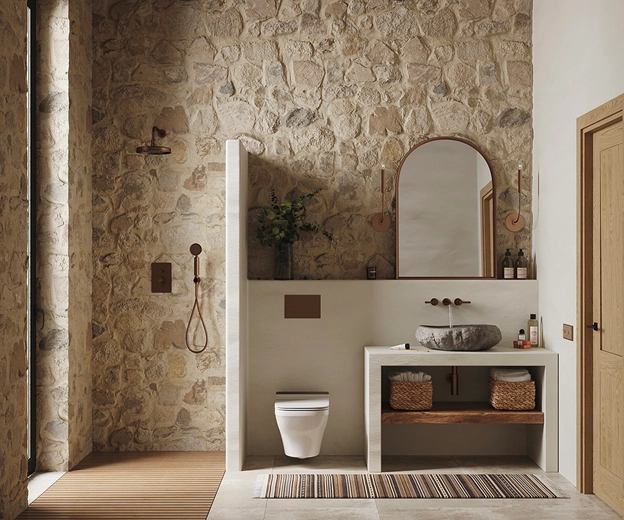
Source: Elena Maramchuk
16. Modern small bathroom walk-in shower layouts
For small bathroom layouts, modern designs are one of the most effective themes because they’re minimalist by nature, offering a clean and decluttered aesthetic. It’s with this design trick that modern layouts can help keep small bathrooms feel light and elegant, especially when you use the same tiles from top to bottom.

iStock: Theltern
17. Scandi walk-in shower ideas
Scandi is similar to modern – they’re both characterised by clean lines, minimalism and neutral tones, which makes them ideal for small bathrooms with walk-in showers. Scandi bathrooms typically have white surfaces and wooden textures, creating a cosy yet modern atmosphere. Scandi blends the natural beauty of rustic with the space-saving functionality of modern design, making it an excellent all-around choice.

Source: Bed Threads
18. White and bright small bathroom walk-in shower layouts
White is the perfect colour for small bathrooms because it makes rooms feel more spacious. When paired with natural light, white is your best bet. You can use all-white tiles for a traditional style or opt for white marble to make your small bathroom feel even more luxurious. If you’re worried about whitewashing your bathroom, you can also add colour accents around the room, whether it’s with an accent wall or colour-themed piping.

Source: Marina Tsishyna
19. Industrial walk-in shower layouts
Industrial design is perfect for small bathroom layouts because it’s minimal. Focusing on metals and wooden materials, the industrial aesthetic allows you to play around with wooden slats, stone slab walls and black metal-framed shower enclosures. These industrial elements should help your small bathroom feel big, beautiful and impressive.

Source: AB Architects
20. Traditional small bathroom layouts
Traditional bathrooms are stylish, timeless and elegant, no matter how small your space. With glossy tiles that create a mirroring effect, traditional decor can make small bathroom layouts with walk-in showers feel much bigger.
For traditional tiles, we recommend white, dark blue or deep green. For best (and most stylish) results, it’s important that you stick to the traditional theme, choosing shower heads and taps reminiscent of the Victorian era.

Source: Kates_Victorian_Home
21. Sloped-ceiling walk-in shower layouts for small bathrooms
As far as small bathroom layouts go, loft conversions and rooms with sloped ceilings can prove the most challenging. However, these awkward rooms offer an opportunity to create a unique walk-in shower layout for your small bathroom. Whether it’s a sloped ceiling or a deep alcove, you can transform unused areas of your home into a special bathroom that saves space.

iStock: Ismagilov
22. 5×8 bathroom with walk-in shower layout
5×8 feet bathrooms are common, but not big. That’s why it makes sense to transform your bathtub into a walk-in shower – you can open up floor space while making it easier for elderly people or those with limited mobility to enjoy safe bathing. As the most common measurement, 5×8 bathrooms will suit almost any decor, from traditional to Bohemian vintage.

Source: Irollyn/Houzz
23. Vintage small bathroom layouts
The best thing about small vintage bathrooms with a walk-in shower is that you don’t need many elements to make it work. All you need is a pedestal sink, matching colour schemes and nostalgic materials, such as pastel-coloured wood or retro tiles. Whether you prefer eclectic layouts or subtle vintage throwbacks, this design will surely impress guests.

Source : Decoholic
24. Boho-inspired layouts
Boho style is an eclectic mix of free-spirited elements, mixing patterns and materials to create a personalised space. While it’s best to keep small bathrooms as minimal and clutter-free as possible in order to maximise space, it doesn’t mean you can’t get creative with your small bathroom layout.
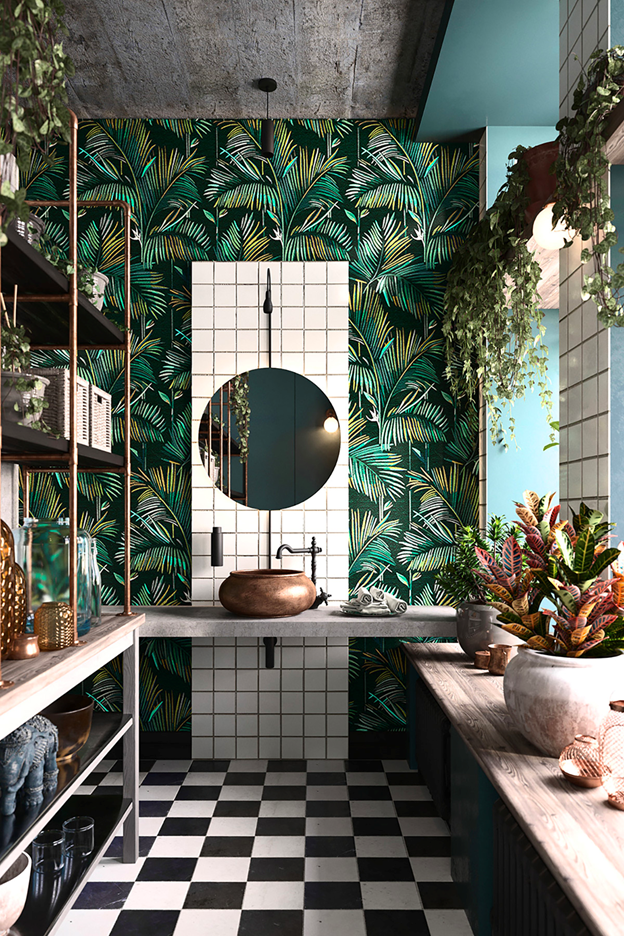
Source: KUT Studio
25. Small bathroom layouts with walk-in shower and curtain
Ideal if you’re on a budget, curtains are cheaper than glass enclosures, and they can make your small bathroom feel bright and elegant, especially when using light or white material. When using a shower curtain, and not a floor-to-ceiling partition, we recommend using a slightly raised step around the walk-in shower to keep the water safely inside the shower area.

Pexels: Charlotte May
Roundup
The best walk-in shower layouts for small bathrooms maximise the limited space in several ways. Whether it’s by using a corner shower to open up floor space or redecorating the bathroom with minimalist themes to help declutter the room, you should always choose the layout that suits your taste and specific bathing needs.
FAQs About Walk-In Showers for Small Bathrooms
What is the smallest size for a walk-in shower?
The smallest size for a walk-in shower could work at 910 x 910 mm, but corner designs can save even more space. For an especially compact bathroom, one could install a 760 x 760 mm shower with a sliding glass door.
How do I make a small bathroom look bigger with a walk-in shower?
Light-coloured tiles, frameless glass doors, and recessed shelving can create an open, airy feel in a small bathroom. Adding a large mirror and good lighting can also make the space appear larger.
What are the best tiles for small walk-in showers?
Large-format tiles with minimal grout lines can make a small walk-in shower feel bigger. Light-coloured tiles like white, beige, or light gray are ideal for small bathrooms. For a modern look, consider textured or patterned tiles on one wall as an accent.
How do I maintain a walk-in shower in a small bathroom?
Wipe up excess water after each use, clean tiles regularly with a mild cleaner, and seal grout lines annually to prevent mould and mildew. Frameless glass doors are easier to clean than framed ones, and have the additional benefit of creating the illusion of a larger space.






































